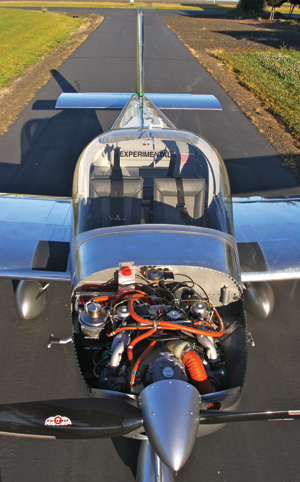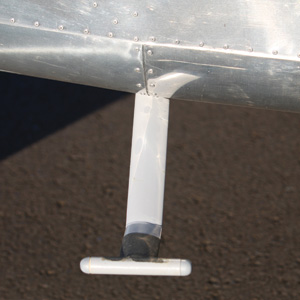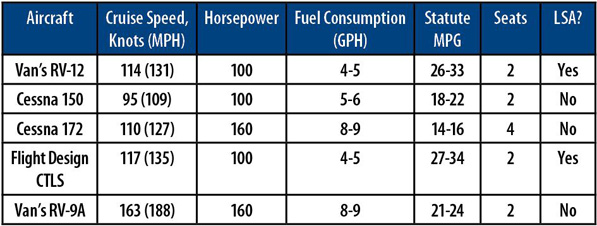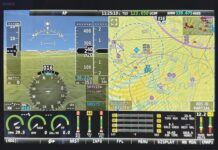
We take it for granted that traditional, full-size, non-Light Sport homebuilts are designed and constructed to fulfill a blend of missions. Sure, you want that Sunday morning getaway machine, one that reminds you of the pure glory of flight as you meander to some nearby destination. But if you want to make the spouse happy and further justify the effort and expense, that airplane should be, shall we say, halfway good at traveling. That means reasonable range, acceptable cabin comfort, sufficient baggage space and the payload to use it.
Again, we don’t think much about the typical homebuilt in the vein of, say, an RV-9 or a GlaStar meeting these requirements-either of them can put serious miles behind you at speeds that shame all but the most expensive store-bought designs, and even then there are significantly faster and/or longer-legged homebuilts to be had. Getting there has never been a problem for Experimentals.
But how about a Light Sport? Can you really make a traveling machine work within the Tupperware-tight container formed by LSA rules? Is this airplane, because of both the weight limitations and speed restrictions imposed by the category, too hobbled to travel effectively?

Demonstrating a takeoff for the camera, Martin hikes the RV-12’s nose up and heads for the pattern.
Well, Let’s See
I set out to answer these questions by calling on former KITPLANES editor Dave Martin. As you probably know, he was one of the early builders of the Van’s RV-12. For Martin, the RV replaced a SkyWalker homebuilt-a limited traveling aircraft if ever there was one. (Truth: The open-cockpit thing is wonderful for a summer evening’s cruise around the local area. Quite another matter when traversing the country, even limited corners of it.) The building part of Martin’s project was chronicled on these pages between September 2009 and March 2010 under the “Independence Project” banner.

Behold the fishmouth. Behind the oval inlet is the Rotax’s single radiator.
Martin feels that the RV-12 kit, while not perfect (are any of them?) was a simple, straightforward project-in fact, he and his building partners were often ahead of the factory’s delivery of the next kit segment. This belief, that the RV-12’s unusual blind-rivet construction and highly developed instructions yield an easy-to-build airplane, is bolstered by the 126 currently flying (as of mid-August 2011) despite the many delays getting parts that initial builders faced and the global economic meltdown that promptly met the RV-12 at the gate. No doubt Van’s would have appreciated brisker sales, so the 12’s success has to be viewed in the context of the times.
Living the good life at the Independence, Oregon, airpark, Martin has flown and flight-tested his airplane extensively among the rolling hills and valleys near his home. But the opportunity had not yet surfaced to put the RV-12 to use as a traveling machine. With the need to fly the Sportsman Turbo Carbon (KITPLANES November 2011) on the opening day of the airshow at Arlington, Washington, I schemed to put the airplane to a fly-out/fly-back test. Martin, for his part, was eager to play along. You have to love the Pacific Northwest in early July; the weather’s fine and the days are long.

Most RV-12s are like this: simple electronic instruments, VFR radios. Dynon’s new SkyView system has supplanted the D180 seen here.
Now, Independence (airport identifier: 7S5) to Arlington isn’t exactly all the way across the country. It’s a bit more than 200 nautical miles in a straight line and 211 n.m. using a flight plan crafted to avoid the busiest part of the Seattle Class B airspace. Call it 2 hours in a Cessna 172 or Piper Cherokee guzzling 8 gallons each hour, or 1.5 hours in my Sportsman 2+2 using 10.5 gph in the cruise phase. This journey is a bit shorter than your typical trip in an entry-level four-seater but long enough to give an impression of the RV-12’s capabilities.

Where most airplanes are designed around the engine, the RV-12 starts with the wide cabin and tall bubble canopy. The narrow, light Rotax 912 fits with ease.
What’s Important?
We had briefed the flight extensively over dinner the night before (followed by a bicycle tour of Independence, a pilot’s haven if ever there was one), so sliding into the RV-12’s cockpit early the next morning provided few surprises. One of Van’s design goals was cabin room and comfort. In part, that’s why the wing’s mainspar is behind the cabin, and passengers enter at the leading edge of the wing. There is no structure underfoot; a low platform covers structure ahead of the mainspar, but it’s well below your knees. Generous footwells are separated by a reasonably narrow center console that’s part structure and part hiding place for systems.
In general layout, the cabin is much like an RV-7 in the “tip-up” configuration. That big bubble canopy hinges forward and swings up far enough that it’s well clear of boarding passengers. Because the RV-12 was intended to be a VFR ship, the instrument panel is smaller than (not as tall as) the other side-by-side RVs. This combination of low cowling, big canopy and pilot position near the leading edge of the wing graces the -12 with exceptional visibility.
Martin slid into the left seat to take the first leg of the day. He’s slightly built and I less so, but we fit comfortably in the 43-inch-wide cabin. Our cargo for the day was limited to the pilot gear he normally carries plus my stupidly large camera bag in the 5-cubic-foot baggage area; a bit less than half of the area behind the seats is given to the fuselage fuel tank, necessary to make the removable wings feasible.

Recessed handles in the wingtips make wing removal simpler.
We could have held more: Thanks to the N812DL’s svelte empty weight of around 725 pounds, a full load of fuel (20 gallons) put us 115 pounds shy of the 1320-pound maximum gross weight. Martin’s airplane originally weighed just 716 pounds empty, but he’s added interior appointments and wheelpants since that time. It’s a testament to the design that a full-size airplane with features such as removable wings weighs so little.
Martin had done us the favor of checking the Rotax’s oil level the night before, so there was no need to do the spin, gurgle, purge, check routine. The startup was pure 912S: choke out, crank and wrestle with the stiff, spring-assisted throttle to keep the idle speed in the desired range. Martin brought the avionics on line. His panel is typically equipped: Dynon FlightDEK-D180 EFIS/engine monitor combo, Garmin GPSMAP 496 moving-map GPS, Garmin SL40 com radio and Garmin GTX 327 transponder. A Flightcom intercom provides pilot-to-copilot harmony. Since the first flights, Martin also installed the optional Dynon autopilot servos and AP74 control head.

Cabin steps are standard. Martin added the rounded dowels to close out the horizontal tube.
This panel layout is clean and logical with a few quirks. Van’s supplies the electrical system, which is based on auto-style blade fuses on a panel with the fuse heads visible to the pilot. Nice idea, but the system is wired so the electric auxiliary fuel pump is always on when the master switch is; if you want to do any work on the airplane powered up, you must remove that fuse. Then you must remember to find it and put it back before flight. (Let’s see: Shirt pocket or did it fall under the seat cushion?) Also, there were some configuration mismatches in the Dynon’s audio alarm modes that caused a screeching in the headsets on every shutdown. We didn’t do a lot of digging in the Dynon’s menu system, but I was dismayed to discover that many of the user-adjustable items are locked out in this special version of the software for the RV-12. More on that later.

Allowing the wings to be removed without having to disconnect the plumbing led the Van’s design team to this novel pitot-tube placement.
A Bright, Beautiful Day
After a pause in the runup area to warm the oil, and then an uneventful runup check, we departed to the north. Martin’s experience in the airplane was evident in the smooth rotation and effortless climbout with the Rotax thrumming away ahead of our toes. I estimate the takeoff roll at around 750 feet, rotation at 45 KIAS and then quickly accelerating to 75 KIAS where Martin retracted the one notch of flaps we’d used for takeoff. Our initial climb took place with the airspeed near 90 KIAS and still resulted in a climb rate of 1000 fpm in the cool morning air. The 912S was taking in just 5.5 gph of unleaded auto fuel. All of the temperatures and pressures were ideal, including an oil temp of 203 F.
Before you grind a fine tip on your Ticonderoga and send a letter wondering why these numbers aren’t the same as Van’s, understand that all RV-12s built the factory way carry a Sensenich two-blade, ground-adjustable prop. Final setting of the prop is up to the builder. After initial flight tests, which indicated that this airplane was carrying slightly too much prop pitch, Martin reset it and very slightly undershot the recommended mark. As a result, we were seeing climb rates in excess of the factory-spec 900 fpm. We might also expect to see slightly less cruise speed for any given engine rpm once leveled off. The other variable here is that Van’s quotes the climb rate in stock condition-no wheelpants or other fairings-so if we have good luck, our cruise speed should hold up to the factory’s quotes.

Pert more than pretty, the RV-12 has distinguished itself as a great-flying, efficient LSA.
Martin, flying with fingertips on the tall stick (with fancy bicycle grips), kept the nose pointed north, and eventually we reached our cruising altitude of 4500 feet MSL. The well-cooled Rotax isn’t particularly fussy about cruise power settings; Martin likes 5000 to 5100 engine rpm at this altitude. He set the throttle for 5100 rpm, which allowed the -12 to wind up to a steady 101 KIAS. The Dynon provided the calculation to true airspeed, 109 knots, based on an outside-air temp of 15 C (giving a density altitude of 5330 feet). Van’s quotes cruise speeds of 116 mph TAS (101 KTAS) at 5000 rpm and 7500 feet MSL, and 131 mph TAS (114 KTAS) at 5500 rpm. Extrapolating from the listed speeds, I’d say we were ahead of the game.

Pitch control comes from a full-span stabilator (elevator and stabilizer as one) with a large anti-servo/trimtab.
Look, Listen, Learn
Once we were established in cruise, there wasn’t much to do but watch the scenery roll by. The Rotax needs little attention-no mixture management at all-and the stone-simple systems mean you need only concern yourself with how much fuel remains in the single tank. The GPS counts down the miles to destination, and with a fuel burn of between 3.8 and 4.1 gph, you run a quick mental calculation to see if you could drive the route on much less fuel. You do the math and double-check it to be sure: At 125 mph TAS on 4 gph (roughly), the zero-wind fuel economy is 31.3 statute miles per gallon. You’d do well to beat that mpg rating in a nasty little Prius at highway speeds, and you’d surely not be doing nearly double the legal speed limit in the process.
I found the cabin and seats to be comfortable and the noise level manageable with active-noise-reduction headsets. I could easily see sitting there for 2 to 3 hours. On our descent into Arlington, I gently accused Martin of cherry-picking his flying leg-we had 15 to 20 knots on the nose for most of the trip, unusual for that altitude in July-to increase his flying time. He didn’t fight the accusation with much conviction. We touched down after 2.2 hours aloft. His pudding-smooth landing punctuated his understanding of the RV-12.

Your well-packed undies share space with boxed unleaded; the RV-12’s 20-gallon fuel tank lives behind the copilot.
Return Trip
After my flight in the Sportsman Turbo Carbon at Arlington (an airplane I’m extremely familiar with that suddenly seemed big, heavy and slow to respond after the RV-12), Martin and I filled the tank with 100LL (no auto fuel was available) and headed south in the early afternoon. Naturally, it was hotter and we expected the atmosphere to be a lot more active than during the morning flight. However, the rest of the weather picture looked ideal: cloudless skies, superb visibility, light winds at the departure and destination points. I was secretly hoping the winds aloft would have moderated; no sense getting cheated out of stick time.
On the takeoff roll, I made the same mistake most new-to-RV-12 pilots do: over-controlling in roll. The RV’s stabilator pitch control is very well sorted, with appropriate stick forces, and the airplane has a strong tendency to return to trimmed airspeed when displaced. But the roll rate is sprightly with low control forces, plus those full-span flaperons have tremendous authority. As a result, I put the nose right where I wanted it during the initial climb but over-managed the stick in roll. I wonder if the traffic departing behind us thought we’d found a wasp in the cabin or something. After a few cycles, I moved my hand down the stick and mentally turned down the gain. Cleaned up and climbing, the RV-12 sloughed off my ham-fistedness, and I vowed to be a bit more tender.

“Hey, did you bring the coffee, Dave?” “No eating in the airplane, Marc.” Sigh.
Leaving the Arlington airport, we traversed some light low-level turbulence, which the RV-12 managed without trouble as long as I remembered to make about half the correction at the stick that my Sportsman-stymied reflexes were calling for. It absolutely moved around more than the double-the-weight Sportsman had just 30 minutes before, but that’s hardly front-page news. Any airplane with a wing loading near 10 pounds per square foot is going to be lively in turbulence. No doubt, my overreaction to the bumps made the ride choppier than it had to be.

Fifteen minutes later, the RV-12 and I had become friends.
With Martin enjoying the view from the right seat, I had a moment to explore the airplane in a bit more detail. I’d noticed on the flight north that Martin had been resetting the throttle often. His RV-12 is fitted with the normal push/pull throttle and screw-down lock, not a vernier-style control. The Rotax’s twin Bing carburetors each have strong return springs that are always trying to pull the throttles open; the idea is that a cable break would give full power instead of no power. Unfortunately, the springs are strong enough to overcome the throttle control’s friction lock. Every few minutes, you have to nudge the throttle back and reset the lock. What a pain. If the RV-12 were mine, I’d substitute a vernier control (as I did on the Rotax-powered Pulsar I built back in the day).

Seattle in the rearview, the journey up to Arlington is almost over.
I also tried the Dynon autopilot for a bit. Martin confessed that he did not have the latest software in the system, so the dropped GPS signal didn’t surprise me (that was a problem fixed with new firmware for the 496 some time ago). Same with the autopilot’s inability to hold altitude smoothly. I couldn’t tell if the latest Dynon software was in place-and Martin wasn’t sure himself-because some of the autopilot settings that are visible to other users are hidden in the software built for the RV-12. I understand the basic logic here, but it’s an unfortunate shortcoming for users who can actually read a manual and fine-tune the many new settings in the Dynon software. Oh, well.

Low stall speeds have a strong side benefit of low approach speeds and short landings.
My time in the left seat ended too soon. An average of 15 knots on the tail put us back in Independence in less than 2 hours. The Dynon displayed a fuel burn of 4.8 to 5 gph most of the trip, an indicated difference we attributed to the use of 100LL fuel. Again, I made a few rookie mistakes in the pattern. The RV-12 is slick, so you’d best arrive in the airport without a lot of excess altitude or speed. Reducing to the desired 55- to 60-KIAS approach speed took idle power and full flaps, and I still wasn’t done. A forward slip helped get me on glideslope but still left me with a bit too much energy. Floating along merrily, 3 feet off the deck, the RV-12 proves intuitive to keep on the centerline while the speed dissipates. With a bit of roll correction for the left crosswind, the left main chirped down just before the right; holding the pitch attitude to ensure daylight under the nosewheel was easy.

Fuel goes in here, just behind the copilot-side rear window. Not much of it, actually.
As we taxied in, Martin turned to me with a look of pure pride. Yes, very nice airplane. Smooth, easy to fly once you understand the quirks, and almost unbelievably efficient. At the start of the day, I’d chafed just a bit at true airspeeds 45% below where I’d been traveling for the last 700 hours, but by the end of the day, the RV-12 and I were in sync.
Answer the Question
Returning to the flimsy premise hastily constructed to give me access to Dave Martin’s fine steed: Does the RV-12 work as a cross-country airplane? The answer is a yes-with an asterisk. How big that disclaimer is really depends on your expectations. At 100 to 110 knots, you’re not going to cover great chunks of the country in a day. But you won’t be going much faster in a Cessna 172 or a Cherokee either, and a Cessna 150 will be chewing on the RV-12’s dust. A Cub? Ha! Pack a lunch, and perhaps even a sleeping bag.

Short final to Arlington. Dave Martin is about to show a visiting journalist how it’s done.

The RV-12 scores incredibly well in efficiency. In fact, you could make the case that you’d consume less fuel taking the airplane as opposed to driving. The limitations of the Light Sport rules manifest in expected ways, a jiggly ride in turbulence and the need to be on the ball when landing during gusty crosswinds or other challenging conditions. (The accident statistics of the early Special Light Sport designs indicate that pilots accustomed to heavier aircraft don’t do well with light-wing-loading designs.) But because of an extremely weight-conscious design, the RV-12 doesn’t run afoul of the biggest LSA shortcoming: low payload. Without being cheap or flimsy, the RV-12 is svelte enough to preserve a truly useful useful load despite the 1320-pound weight limit. Add in good performance for 100 hp, a well-regarded company behind it and a modest initial outlay-the RV-12 ELSA kit costs $63,165 to $63,740 depending on basic options, including engine, propeller and avionics but less paint-and the RV-12 makes a strong case for itself. Whether you take it traveling is up to you.
For more information on the Van’s RV-12, call 503/678-6545, or visit www.vansaircraft.com.

Low, slow (actually, not so slow), and deliciously efficient. The RV-12 is more than entertaining on an early-morning mission.













